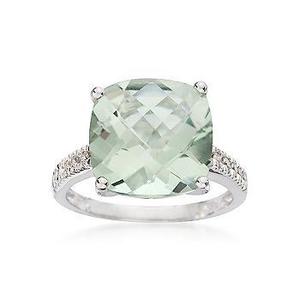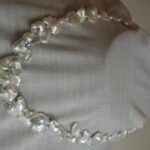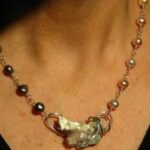Prasiolite is the perfect gemstone. Why perfect? Because it makes a crystal clear presentation in a pleasing pale-green celadon color, comes in large carat weights, and is cheap. Too good to be true? I could convince you, but you be the judge.
A lot in the name
Another name for prasiolite is green amethyst. Sources of naturally green amethyst exist, but they are few, far between, and not abundant. The gemstone we know in the market as prasiolite or green amethyst, more often than not, is an enhanced gemstone that started out as poor-color-quality amethyst.
Prasiolite is also known as vermarine and amegreen. Green quartz is the most descriptive alternative name because prasiolite is a quartz like all other silicon dioxides (SiO2), and it is indeed green.
Green amethyst is an accurate name for prasiolite as well, because what started out as amethyst turned green upon human enhancements. Marketers prefer to call prasiolite green amethyst best, because it is indeed an amethyst that’s green and sells better with a more familiar gemstone name. Besides, ‘amethyst’ just sounds more valuable.
Treatment to green
The enhancement of amethyst to prasiolite consists of a combination of heat treatment and cobalt-60 irradiation. Heat treatment alone yields yellow, producing the gemstone we know as citrine. Combining the gamma emissions of cobalt-60 with the heat treatment moves the resulting color to the pale green we know as prasiolite.
To confuse matters on the name, prasiolite is seen spelled as praziolite, which is a correct alternative. Praseolite, with that e in the middle, however, is a similarly colored but completely different stone: a cordierite, not a quartz. Check your spelling and know what you’re getting.
Pale green color
If the name isn’t confusing enough, the pale green color gives rise to misidentification of prasiolite as other gemstones. It may be wishful thinking for prasiolite to be mistaken as peridot, tourmaline, zultanite or green beryl. These are rarer, hence more expensive, gemstones.
Depending on the depth of the green color and clarity, prasiolite can also be mistaken for prehnite, demantoid garnet, tsavorite garnet, or chrome diopside. It depends on how well you can convince yourself that you’ve got a glorious green beauty instead of a pretty, but common, quartz.
Common treatment
It is this common quality that makes prasiolite affordable, despite that human interventions took over where nature left off. To know and regard enhancements as undesirable is missing the opportunity to enjoy all the beauty a gemstone can be.
Send your prasiolite jewelry over to me if you think it’s inferior because of disclosed heat treatments or other enhancements. Send it over, too, if you think radiation still lurks in the stone. Don’t worry, ladies, no gamma rays remain after irradiation. Those who think so skipped seventh grade science.
New designer gemstone
You’ll be attracted to prasiolite in gorgeous glittering designer jewelry, perhaps adding the affordable beauty to your “green” gemstone repertoire.







